BSD High Power Rocketry Little John
BSD High Power Rocketry - Little John {Kit}
Contributed by Jim Hendricksen
| Construction Rating: | starstarstarstarstar |
| Flight Rating: | starstarstarstarstar |
| Overall Rating: | starstarstarstarstar |
| Manufacturer: | BSD High Power Rocketry  |
 Brief:
Brief:
This is a great kit for some one wanting to try dual deployment for the first
time. A great looking sport scale rocket that comes with almost everything you
need, altimeter bay, tubular nylon (rather than elastic shock cord supplied
standard!), rail buttons, and launch lug (giving you a choice depending on your
clubs launching pad set up). The only thing you need to add are a parachute or
parachutes, depending on whether you want to fly main only or dual deploy. It
can also be flow main only with motor ejection. You must cut the fin slots your
self, but the instructions take you through it step by step. No big deal. If
you can draw a straight line with a pencil and ruler, you can do this!
Construction:
the following items are supplied for construction:
- 1 3.9" x 14" airframe tube
- 2 3.9" x 10" airframe tube
- 3 3.9" tubing couplers
- 4 3/16" birch ply fins sanded
- 4 3/16" birch ply strake fins sanded
- 1 54mm x 11.25" motor tube
- 1 4" plastic nose cone
- 2 6-32 x 1-1/2" allen head bolts
- 2 6-32 blind nuts
- 2 motor retaining clips
- 2 3.9" bulkhead plates
- 2 3.9" centering rings
- 1 1/2" x 4" launch lug
- 2 rail buttons
- 3 heavy duty 1/4" eyebolt assembly
- 2 3/16" quick links
- 1 9/16" x 6' tubular nylon
- 1 9/16" x 12' tubular nylon
- 2 3' heavy duty nylon shock cord straps with grommets
- 1 Little John decal pack [black and white supplied]
- Instruction book and 1 fin alignment guide
To complete the construction you will need 15 min epoxy for airframe assembly and 30 min epoxy for fin fillets, razor blades for cutting fin slots, and the standard sandpaper and paint for finishing. I used 125 grit sandpaper and Krylon spray paint.
If you have never built a BSD kit or are new into high power, you need to try one. They have the easiest to follow, step-by-step, photo-illustrated instruction manual going! But please, please, please read it through before beginning to apply epoxy! Test fit and sand if needed to assure a good alignment and fit. Remember the old saying "measure twice and cut once"? It is never held truer than in building high-power rockets.
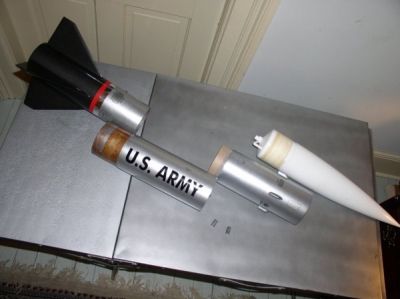 Now the only
little gotcha I found was in drilling and installing the eye bolt in the
forward centering ring on the motor mount. Between having a 54mm motor mount in
a 4 inch frame there is little room, you must position the eyebolt a little
off-center and turned sideways leaving just enough room to get a quick link
through the eyebolt hole. When the payload section is lowered into the booster
section, the coupler must slide by the eyebolt and bottom out by almost
touching the upper centering ring on the motor mount. So after assembling the
motor mount tube but before tightening the eyebolt, slide it into the airframe,
lower a coupler into the airframe down to the top centering ring with eyebolt
to make sure you can attach a quick link and that the coupler is free to slide
in and out without binding! If it binds, turn the eyebolt till you get the
proper fit. This is a must for the final fit to be proper! Do this before
epoxying the motor mount to the airframe, and you will have no problems in
building this kit. The rest of the assembly went without any problems.
Now the only
little gotcha I found was in drilling and installing the eye bolt in the
forward centering ring on the motor mount. Between having a 54mm motor mount in
a 4 inch frame there is little room, you must position the eyebolt a little
off-center and turned sideways leaving just enough room to get a quick link
through the eyebolt hole. When the payload section is lowered into the booster
section, the coupler must slide by the eyebolt and bottom out by almost
touching the upper centering ring on the motor mount. So after assembling the
motor mount tube but before tightening the eyebolt, slide it into the airframe,
lower a coupler into the airframe down to the top centering ring with eyebolt
to make sure you can attach a quick link and that the coupler is free to slide
in and out without binding! If it binds, turn the eyebolt till you get the
proper fit. This is a must for the final fit to be proper! Do this before
epoxying the motor mount to the airframe, and you will have no problems in
building this kit. The rest of the assembly went without any problems.
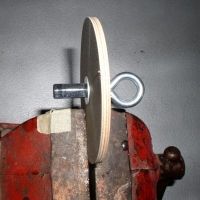 This kit is great
because it comes with a built in altimeter bay. The manual calls for holding it
together with plastic rivets. I have done this in the past, and it works just
fine. However, at a recent launch I saw a different method and chose to
incorporate it into this build: it required only a short section of 1/4"
all-thread and two 1/4" coupling nuts. Instead of using the supplied nut
to secure the eyebolt to the bulkhead plate in the altimeter bay, use a coupler
nut and attach the all-thread, epoxying them together. On the other bulkhead
plate, pass the eyebolt through a washer, then the bulkhead plate, through
another washer and into the other coupler nut. Tighten the eyebolt snug but
leave just enough play that you can turn the assembly freely. When you have
adjusted it properly you can epoxy the coupler nut to the washer and eyebolt
but not to the bulkhead plate. This will leave the assembly free to turn in the
bulkhead. Now all you have to do to attach the
This kit is great
because it comes with a built in altimeter bay. The manual calls for holding it
together with plastic rivets. I have done this in the past, and it works just
fine. However, at a recent launch I saw a different method and chose to
incorporate it into this build: it required only a short section of 1/4"
all-thread and two 1/4" coupling nuts. Instead of using the supplied nut
to secure the eyebolt to the bulkhead plate in the altimeter bay, use a coupler
nut and attach the all-thread, epoxying them together. On the other bulkhead
plate, pass the eyebolt through a washer, then the bulkhead plate, through
another washer and into the other coupler nut. Tighten the eyebolt snug but
leave just enough play that you can turn the assembly freely. When you have
adjusted it properly you can epoxy the coupler nut to the washer and eyebolt
but not to the bulkhead plate. This will leave the assembly free to turn in the
bulkhead. Now all you have to do to attach the
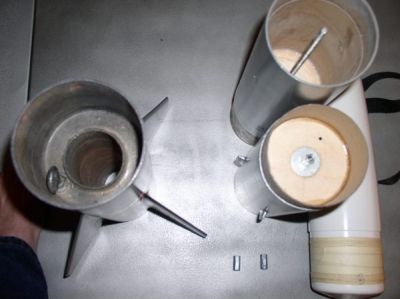 two sections
together, is push the upper bulkhead plate onto the all-thread and twist the
eyebolt until tight! For those who don't know what a coupler nut is, it is
about 1 inch long and open on both ends, to allow connecting two sections of
all-thread together or a section of all-thread to an eyebolt. They can be found
at Lowe's, Home Depot or most hardware stores for about $0.75 apiece. 1/4"
all-thread can be found same places also about $2.00 for a 36" section.
You will need approximately a 5 1/2" section if you decide to do this.
Final length is determined by the location you decide to glue your bulkhead
plate
two sections
together, is push the upper bulkhead plate onto the all-thread and twist the
eyebolt until tight! For those who don't know what a coupler nut is, it is
about 1 inch long and open on both ends, to allow connecting two sections of
all-thread together or a section of all-thread to an eyebolt. They can be found
at Lowe's, Home Depot or most hardware stores for about $0.75 apiece. 1/4"
all-thread can be found same places also about $2.00 for a 36" section.
You will need approximately a 5 1/2" section if you decide to do this.
Final length is determined by the location you decide to glue your bulkhead
plate
Finishing:
I decided to give fiberglassing a try on this rocket. It definitely is not
needed but I felt it was just time for me to learn. It went much easier than
anticipated and I urge all to try it when you think the time is right. If you
continue on in this sport, sooner or later you will want this skill. I can
report to you it is not nearly as difficult as many would have you think! There
are many articles on this subject on the web and I assume if you are reading
this, you know how to find them. I will give the short version of my
experience. I used some easy glass sock, which is a tube of cloth that
stretches right over the airframe, available from Giant Leap Rocketry. One 9
ounce kit of finishing epoxy was more than enough. When it was almost cured
(about 5 hours), I wrapped 2 layers of 2 ounce glass cloth (sometimes called
veil cloth) over it. It is not needed but makes filling almost pointless,
because with some light sanding, a couple of coats of Krylon primer and finish
coats, I was done. I chose black for the fin can, metallic silver for the
airframe, and gloss white for the nose cone. After letting it dry for 2 days, I
applied the provided decals and a red and chrome stripe of my own. It may not
be true to scale, but it is a great looking rocket and has received many
compliments!
Construction Rating: 5 out of 5
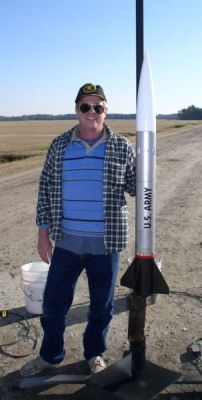 Flight:
Flight:
The motor retention supplied by BSD is simplicity itself and works fine. A
couple of blind t-nuts and 2 allen head bolts hold the clips on the motor. All
you need is an allen wrench (not included) for it. I suppose you could use
pliers if need be but I had the required allen wrench.
I decided to go for broke on my first flight and loaded up an AeroTech 54mm J275 with medium delay (10 seconds). The day was perfect; sunny, no wind, and not a cloud in the sky. Loaded up my Missile Works RRC2, set the main for 500ft, put her on the rail, took the mandatory dumb rocket photos (you never know if you'll see it again! haha), and away she went. And boy did she go! This rocket weighed in at 6lbs 5oz totally loaded for the pad. The flight was straight as an arrow and the drogue deployed perfectly at apogee. After a lengthy fall the main opened on cue. Upon return to earth the RRC2 was beeping out 4154ft. Could not ask for a better flight. Thanks BSD!
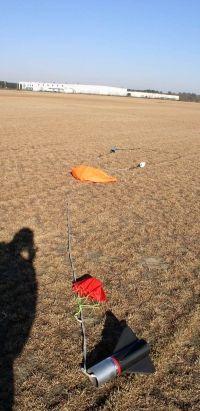 Recovery:
Recovery:
For recovery I used the supplied nylon shock cord straps but used longer
9/16" tubular nylon (TN). For the apogee event: 20ft TN and a 18 in BSD
drogue chute. For the main event [no pun intended]: 25ft TN and a 60"
hemispherical chute from Spherachute. It may have been overkill (BSD recommends
a 45" chute) but there was no wind and it made for a beautiful landing.
The motor ejection was used for drogue with altimeter backup and 1.5 grams of
FFFFg for main deployment with Daveyfire E-match. Cellulose wadding was used.
There was no scorching or burning of either shock cords or chutes and no damage
to the rocket at all, however, careful folding of chutes and shock cords was
required to make it all fit properly.
Flight Rating: 5 out of 5
Summary:
This is a great kit and contains absolutely everything except for parachutes!
No need to buy motor retention or rail guides. The built-in altimeter bay makes
building a breeze. The looks you will get when people see this small rocket
with a 54mm mount going to the pad are always a hoot. It can be flown on a
variety of motors and yet is strong enough to take the punch of large K motors
built stock. The only reason I fiberglassed it was because I thought it would
be easier to learn on a smaller rocket. The supplied instruction manual is one
of the best I have ever seen. Step-by-step instructions and plenty of photos
ensure a perfect build. Nothing left to wonder about here!
Overall Rating: 5 out of 5
 |
 |
Flights
 |
 |